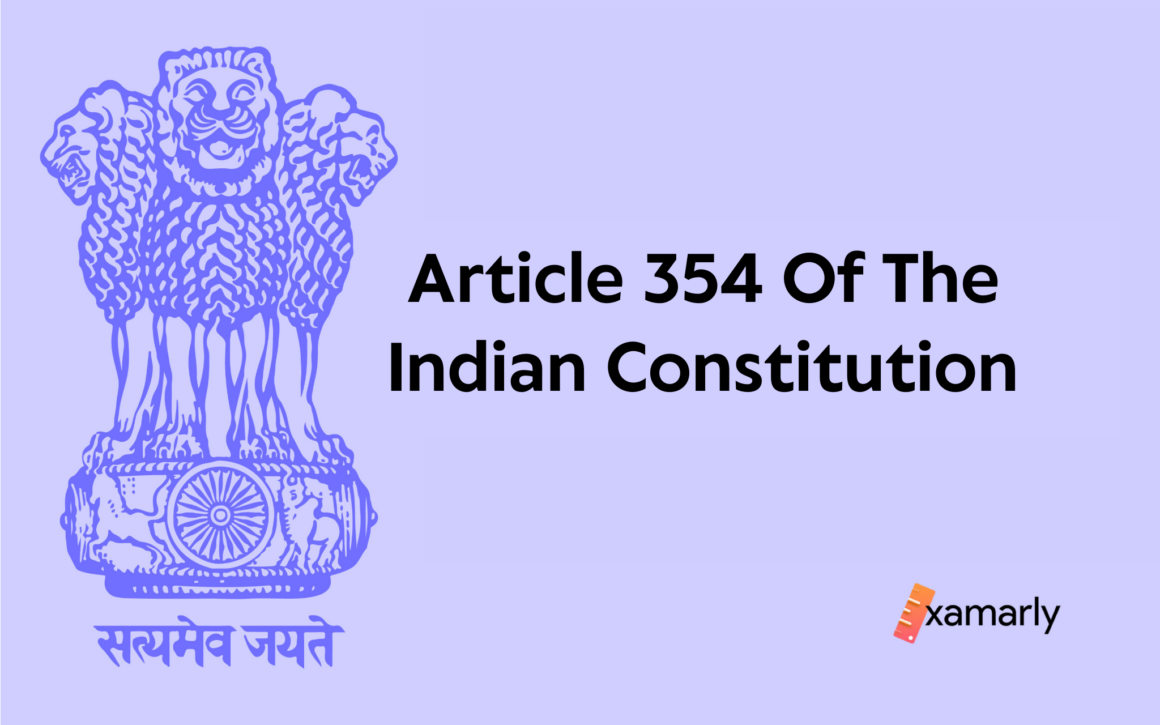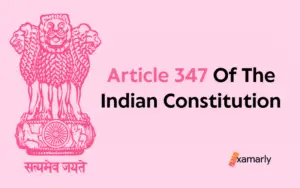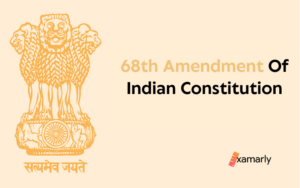Article 354 of the Indian Constitution deals with the application of provisions related to the distribution of revenues while a Proclamation of Emergency is in operation. This article outlines the conditions under which the distribution of revenues between the Union and the States can be altered during a state of emergency.
It also outlines the procedure for making such changes and the duration for which they can remain in effect.
Adding to that, it also makes sure that the President’s decision is reviewed and makes it mandatory to lay it before the House of Parliament.
- Background of Article 354 Of The Indian Constitution
- Article 354 of the Indian Constitution
- Conclusion
- FAQs Related to Article 354 of the Indian Constitution
- Which part of the Indian Constitution does Article 354 belong to?
- When was Article 354 of the Indian Constitution adopted?
- What is Article 354 of the Indian Constitution?
- What is the purpose of Article 354 of the Indian Constitution?
- How does Article 354 of the Indian Constitution empower the President?
- What are the limitations of the President's power under Article 354 of the Indian Constitution?
- What happens to the order made by the President under Article 354 of the Indian Constitution?
- What is a National Emergency in India?
- How long can a National Emergency last in India?
- What happens during a National Emergency in India?
- What are the types of National Emergencies in India?
- How many times has a National Emergency been declared in India?
- Can the citizens of India appeal the declaration of National Emergency?
- How is revenue distributed between the Union and the states in India?
- What are the main sources of revenue for the states?
- What are the main sources of revenue for the Union government?
Background of Article 354 Of The Indian Constitution
Article 277 of the Draft Constitution of India, 1948 stated:
The President may, while a Proclamation of Emergency is in operation, by order, direct that all or any of the provisions of articles 249 to 259 of this Constitution shall for such period, not extending in any case beyond the expiration of the financial year in which such proclamation ceases to operate, as may be specified in the order, have effect subject to such exceptions or modifications as he thinks fit.
Draft Article 277, also known as Article 354 of the Indian Constitution, was discussed and debated in the Assembly on August 19th and 20th, 1949. This article empowers the President of India to temporarily modify the financial relationship between the Union (Central Government) and the States during a state of emergency. However, during the discussion, some members of the Assembly raised concerns about the potential consequences of this article on the States.
One concern that was raised was that the President could pass orders that may impact the States’ financial obligations and planned expenditures, potentially leading to financial hardship for the States. Additionally, some members were concerned about the wide powers and discretion given to the President under this article.
To address these concerns, a Draft Committee member reminded the Assembly that the President’s orders would be temporary and no permanent changes could be made to the fiscal relationship between the Union and the States. The Chairman of the Drafting Committee also reassured the Assembly that the President’s orders would be reasonable, measured, and appropriate for the prevailing circumstances.
Furthermore, the Drafting Committee Chairman proposed an amendment at the beginning of the debate that would require parliamentary approval for the President’s orders. He felt that it would not be wise to leave Union-State financial arrangements to the President’s discretion without any oversight by the Parliament. This amendment helped to alleviate the concerns of some members who felt that the Draft Article gave the President too much power.
In the end, the Assembly accepted the Chairman’s amendment and rejected other proposed amendments. Draft Article 277 was adopted with the amendment on August 20th, 1949.
Article 354 of the Indian Constitution
Article 354 of the Indian Constitution is an essential provision in the Constitution as it ensures that the government has the necessary financial resources to deal with an emergency situation, while also protecting the rights of the States. Let’s break down its clauses and understand the provisions better.
Clause 1 – As it is & Explained
(1) The President may, while a Proclamation of Emergency is in operation, by order direct that all or any of the provisions of articles 268 to 279 shall for such period, not extending in any case beyond the expiration of the financial year in which such Proclamation ceases to operate, as may be specified in the order, have effect subject to such exceptions or modifications as he thinks fit.
According to the first clause of Article 354 of the Indian Constitution, during a state of emergency, as declared by a Proclamation issued by the President of India, the President has the authority to temporarily alter certain aspects of the Indian Constitution related to the distribution of revenues between the Union (Central Government) and the States.
Specifically, the President may issue an order, directing that certain provisions, outlined in Articles 268 to 279 of the Indian Constitution, shall have effect subject to certain exceptions or modifications.
These modifications or exceptions can only be made for a specific period of time, and cannot extend beyond the expiration of the financial year in which the Proclamation of Emergency ceases to operate.
This provision gives the President the power to make necessary changes to the distribution of revenues between the Union and the States during an emergency situation, in order to ensure that the government has the necessary financial resources to deal with the emergency.
However, it also ensures that these changes are temporary, and cannot become permanent. Additionally, it also ensures that the rights of the States are protected and that there is proper oversight in place, by limiting the period of these modifications.
Clause 2 – As it is & Explained
(2) Every order made under clause (1) shall, as soon as may be after it is made, be laid before each House of Parliament.
Clause (2) of Article 354 of the Indian Constitution states that every order made by the President under Clause (1) shall be presented before both Houses of the Indian Parliament as soon as possible after it is made.
This means that any order issued by the President under Clause (1) of Article 354, which allows him to temporarily modify certain provisions related to the distribution of revenues between the Union and the States during a state of emergency, must be immediately presented before the Lok Sabha (the Lower House of the Indian Parliament) and the Rajya Sabha (the Upper House of the Indian Parliament) for review and approval.
This clause is an important aspect of the article as it ensures that there is parliamentary oversight of any changes made to the distribution of revenues during a state of emergency.
It allows for the elected representatives of the people to review and approve the changes made by the President and ensures that these changes are in the best interest of the nation and its citizens. It also ensures that the President’s discretion is not unfettered and any order made is not arbitrary.
This is an important provision in the Indian Constitution as it ensures that the government’s actions are transparent and accountable to the citizens it serves.
Conclusion
In conclusion, Article 354 of the Indian Constitution plays a vital role in ensuring that the government has the necessary financial resources to deal with an emergency situation, while also protecting the rights of the States.
This article empowers the President to temporarily modify certain provisions related to the distribution of revenues between the Union and the States during a state of emergency.
The provision gives the President the power to make necessary changes to the distribution of revenues between the Union and the States during an emergency situation, in order to ensure that the government has the necessary financial resources to deal with the emergency. However, it also ensures that these changes are temporary, and cannot become permanent.
At the same time, clause (2) of Article 354 of the Indian Constitution ensures that there is parliamentary oversight of any changes made to the distribution of revenues during a state of emergency, which allows for the elected representatives of the people to review and approve the changes made by the President and ensures that these changes are in the best interest of the nation and its citizens.
Overall, Article 354 of the Indian Constitution is an important aspect of the Indian Constitution, as it allows for necessary modifications to be made to the financial relationship between the Union and the States during a state of emergency, while also ensuring that the rights of the States are protected and that there is proper oversight in place.
Related Articles:
- Article 268 Of The Indian Constitution
- Article 269 of the Indian Constitution
- Article 270 Of The Indian Constitution
- Article 271 Of The Indian Constitution
FAQs Related to Article 354 of the Indian Constitution
Which part of the Indian Constitution does Article 354 belong to?
Article 354 of the Indian Constitution belongs to Part XVIII which is called Emergency Provisions.
When was Article 354 of the Indian Constitution adopted?
Draft Article 277 (Article 354 of the Constitution of India 1950) was adopted on 20th August 1949.
What is Article 354 of the Indian Constitution?
Article 354 of the Indian Constitution deals with the application of provisions related to the distribution of revenues between the Union and the States while a Proclamation of Emergency is in operation. It empowers the President to temporarily modify certain provisions of the Constitution related to the distribution of revenues during a state of emergency.
What is the purpose of Article 354 of the Indian Constitution?
The purpose of Article 354 of the Indian Constitution is to ensure that the government has the necessary financial resources to deal with an emergency situation, while also protecting the rights of the States. It allows for necessary modifications to be made to the financial relationship between the Union and the States during a state of emergency, while also ensuring that the rights of the States are protected and that there is proper oversight in place.
How does Article 354 of the Indian Constitution empower the President?
Article 354 of the Indian Constitution empowers the President to temporarily modify certain provisions of the Constitution related to the distribution of revenues between the Union and the States during a state of emergency. The President may issue an order directing that certain provisions shall have effect subject to certain exceptions or modifications for a specific period of time.
What are the limitations of the President’s power under Article 354 of the Indian Constitution?
The President’s power under Article 354 of the Indian Constitution is limited to the duration of a Proclamation of Emergency and any modifications or exceptions made under this article can only be made for a specific period of time, and cannot extend beyond the expiration of the financial year in which the Proclamation of Emergency ceases to operate. Additionally, Clause 2 of the article ensures that there is parliamentary oversight of any changes made to the distribution of revenues during a state of emergency, which allows for the elected representatives of the people to review and approve the changes made by the President.
What happens to the order made by the President under Article 354 of the Indian Constitution?
Every order made by the President under Article 354 of the Indian Constitution must be presented before both Houses of the Indian Parliament as soon as possible after it is made, for review and approval. This ensures that there is parliamentary oversight of any changes made to the distribution of revenues during a state of emergency and that the changes are in the best interest of the nation and its citizens.
What is a National Emergency in India?
A National Emergency in India is a state of emergency declared by the President of India, under Article 352 of the Indian Constitution, in the event of a grave threat to the security, integrity, or financial stability of the nation. A Proclamation of Emergency can be issued in the event of war, external aggression, armed rebellion, or a breakdown of the constitutional machinery of a State.
How long can a National Emergency last in India?
A Proclamation of Emergency can remain in effect for a maximum of six months, after which it must be approved by a resolution of both Houses of Parliament. If approved, the emergency can continue for an additional six months, after which it must be reviewed and approved by Parliament every six months.
What happens during a National Emergency in India?
During a National Emergency, the President may take special measures to ensure the security and integrity of the nation. These measures may include the suspension of certain fundamental rights of citizens, deployment of the Armed Forces, and modification of the distribution of revenues between the Union and the States.
What are the types of National Emergencies in India?
There are three types of National Emergency in India; a Proclamation of Emergency on the grounds of war or external aggression (Article 352), a Proclamation of Emergency on the grounds of armed rebellion (Article 352), a Proclamation of Emergency due to the breakdown of constitutional machinery in a State (Article 356).
How many times has a National Emergency been declared in India?
A National Emergency has been declared in India three times since its independence. The first two were declared on the grounds of external aggression (1962 and 1971) and the third one was declared due to internal disturbance (1975-1977).
Can the citizens of India appeal the declaration of National Emergency?
Yes, the citizens of India have the right to challenge the declaration of a National Emergency in a court of law. The Supreme Court of India can review the Proclamation of Emergency and the actions taken under it, to ensure that it is in compliance with the Constitution of India.
How is revenue distributed between the Union and the states in India?
In India, revenue is distributed between the Union (federal government) and the states through a system of taxation and grants. The Union government collects certain taxes, such as income tax and customs duties, while the states collect other taxes, such as sales tax and stamp duty. The Union government also provides grants to the states to support specific activities or to compensate for revenue losses.
What are the main sources of revenue for the states?
The main sources of revenue for the states in India include sales tax, stamp duty, land revenue, taxes on vehicles and minerals, and state excise taxes on alcohol and tobacco.
What are the main sources of revenue for the Union government?
The main sources of revenue for the Union government in India include income tax, customs duties, excise duties, and service taxes.






